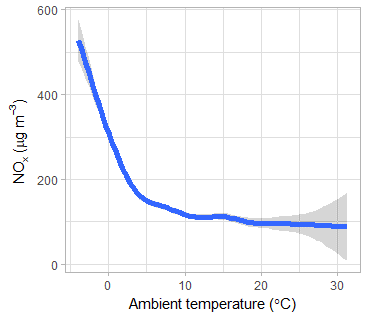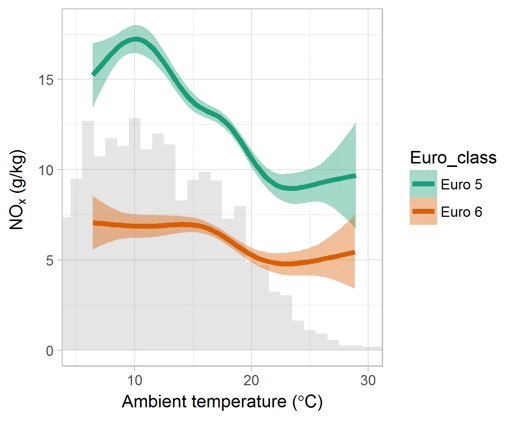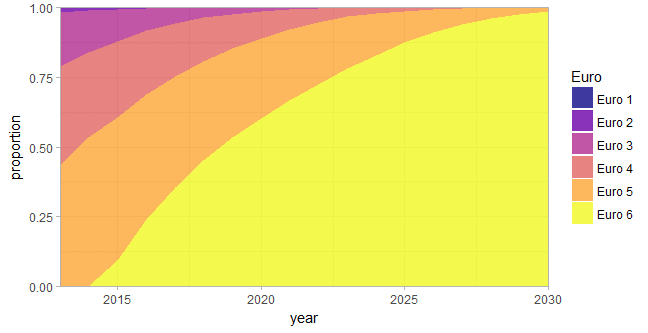
Higher wintertime emissions?
11 Dec 2017
As we head into deepest winter, it is worth thinking about how lower air temperatures affect air quality. Ambient temperature is an important factor that strongly influences the concentrations of pollutants in the atmosphere. Under cold, stable atmospheric conditions, dispersion of emitted pollutants can be greatly reduced, which can lead to high pollutant concentrations and wintertime pollution episodes. During these conditions, it is very difficult to know the extent to which high concentrations are driven by the prevailing meteorological conditions or as a result of increases in emissions from the numerous emission sources that contribute to the ambient concentrations in the air we breathe. Increased use of domestic gas for space heating during the coldest times of the year is to be expected; perhaps less obvious is the potential for changes in emissions from road vehicles.
Even with sophisticated statistical analysis of ambient concentration data it is far from easy to disentangle the relative contributions from increases in emissions and the effect of meteorology. In this blog, I will take a closer look at how emissions from road vehicles change with ambient temperature, informed by Ricardo’s database of vehicle emissions.
Because our remote sensing measurements have been made under a wide range of meteorological conditions, it is possible to establish the extent to which ambient temperature affects the emissions from different types of vehicle and fuel.
So how much do ambient concentrations of NOx vary by ambient temperature? Figure 1 shows an example of the variation in NOx with ambient temperature for a site on the A2 Old Kent Road, London in 2016. It shows that ambient concentrations of NOx markedly increase when the temperature is below 10°C. In fact, there is a factor of three increase in the concentration of NOx when temperature is reduced from 20 to 0°C. The variation of NOx (or other pollutants) with temperature varies by site, but the pattern shown in Figure 1 is typical. However, Figure 1 does disguise the influence of other important factors such as wind speed, which also tends to be lower at lower temperatures – such complexities reinforce the difficulty in establishing the different influences on the ambient concentrations.

Figure 1: Variation in NOx concentration with ambient temperature for 2016 at a location on the A2 Old Kent Road, London.
Traditionally, almost all emission factors for road vehicle emissions assume that emissions do not vary with ambient temperature – but is that right? To help explore how emissions change with ambient temperature we have drawn upon our remote sensing database of vehicle emissions that contains emissions data across a wide range of ambient temperatures (6 to 29°C) covering many different measurement locations. I have focussed on emissions of NOx from Euro 5 and 6 diesel passenger cars.

Figure 2: Effect of ambient temperature on emissions of NOx from Euro 5 and 6 diesel passenger cars. 17,000 measurements. The histogram shows the distribution of ambient temperature in London for 2016.
The variation in NOx for Euro 5/6 diesel passenger cars with ambient temperature is shown in Figure 2. The most striking feature of this plot is how much ambient temperature affects the emissions from Euro 5 vehicles: there is about a 50% increase in emissions as ambient temperature drops from 25°C to 10°C. The emissions from Euro 6 vehicles is also temperature dependent albeit the absolute emissions are much lower than for Euro 5 – nevertheless the effect is still there.
It is interesting to note that many vehicle emission measurements are made in the range 20 to 30°C, such as those made as part of the Type Approval measurements. The Figure 2 histogram shows that, in London, there is a significant fraction of the year with temperatures below 20°C (in fact about 90% of the year has temperatures below 20°C). The combination of the prevalence of lower ambient temperatures in the UK and the evidence for increased emissions from Euro 5/6 diesel cars, suggests there may be reasons to suspect that emissions from these vehicles are underestimated. Moreover, the underestimation might be expected to vary by time of day with higher emissions occurring in the morning when ambient temperatures are lowest and traffic levels at their highest.

Figure 3: Proportion of diesel cars in the UK weighted by distance travelled.
If it is the case, as appears from the data, that Euro 5 diesel vehicles are more sensitive to ambient temperature than Euro 6, then it is worth reflecting on the numbers of these vehicles in the fleet. As shown in Figure 3, in 2017 we have past ‘peak’ Euro 5 in terms of numbers of vehicles (the maximum number of Euro 5 vehicles in the fleet occurred in 2014). In the coming years as the Euro 5 fleet decreases, it can be expected there will be a decreased influence of enhanced emissions under low temperature conditions. As a result, it might be expected that there could be greater reductions in NOx emissions than expected in the future because these temperature effects have not been considered in emission inventory projections.
Even though Ricardo’s database of remote sensing vehicle emissions is comprehensive, there is still a lack of measurements at lower temperatures. This issue however, is currently being addressed through our ongoing measurements in London, in support of the International Council on Clean Transportation’s (ICCT) ‘The Real Urban Emissions Initiative (TRUE)’, which will collect data across the winter period.
These results also suggest that great care is needed when trying to rank vehicles in terms of their emissions. Unless carefully controlled for ambient temperature it is difficult to say with confidence that the difference in emissions between vehicles is due to real differences between vehicles or an artefact of the influence of ambient temperature (or indeed many other environmental factors) when the measurements were made. Moreover, the results shown in Figure 2 are averages across whole Euro classes. There are however, different temperature dependencies that vary based on individual vehicle manufacturers that can be disaggregated to the engine-specific level. The ranking of vehicles could therefore differ with ambient temperatures.
We continue to unpick these and other effects. As the richness of our remote sensing emissions database increases we will be able to provide a more robust understanding of the effect of ambient temperature on vehicle emissions, and build an even greater understanding of the influence of ambient temperature.




 Follow Ricardo plc for regular updates
Follow Ricardo plc for regular updates





